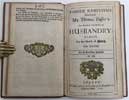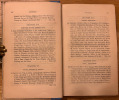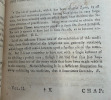Tusser.
Thomas
- A popular Tudor work.
Tusser Redivivus:
Being part of Five Hundred POINTS of HUSBANDRY; DIRECTING What Corn, Grass, &c. is proper to be sown; What Trees to be Planted; How Land is to be Improved: with what ever is fit to be done for the Benefit of the Farmer in every Month of the Year. To which is added NOTES and OBSERVATIONS explaining many obsolete Terms in the said Mr Tusser, and what is agreeable to the present Practice in several Counties of this Kingdom. A WORK very necessary and useful for Gentlemen, as well as Farmers and Occupiers of Land, whether Wood-Ground, Tillage or Pasture. [a fine straight line] LONDON: Printed, and are to be sold by J. Morphew near Stationers-Hall. 1720. [the whole page with neat double-line border].
190.5 x 127 mm. Twelve monthly parts in eleven (as published, with November and December on the last title page). 1 new fep. Main Title page. [1] January - Title page, Preface on the verso, 3-16 and separate pagination. February - Title page. 3-16 and separate pagination. March - Title page. 2-16 and separate pagination. April - Title page [1]. 3-16 and separate pagination. May - Title page [1]. 3-16 and separate pagination. June - Title page. 2-16 and separate pagination. July - Title page. 2-16 and separate pagination. August - Title page. 2-16 and separate pagination. September - Title page. 2-16 and separate pagination. October- Title page. 2-16 and separate pagination. November and December - Title page. 2-16 and separate pagination. 1page Advertisement. 1 new fep. The Title page has a small repair at the top of the page with no loss. Illustrated with fine large woodcut vignettes in each chapter. (the first 4 vignettes very nicely and pleasingly coloured in yellow). The whole text block is slightly age-browned and clean. Nicely bound in modern full tan calf with raised bans on the spine, with a red calf label and gilt lettering. Overall very good complete copy.
-
First printed in 1557, this book has a charming format, giving instructions on farming in England throughout the year. An early adherent of seasonality, Tusser's writing is both witty and informative. His major work was first the ‘Hundredth Good Pointes of Husbandrie’, published by Richard Tottel and frequently reprinted. Tottel published an enlarged edition ‘Five Hundreth Pointes of Good Husbandrie’ in 1573.
Tusser includes a homely mix of instructions and observations about farming and country customs which offer a fascinating insight into life in Tudor England, and his work records many terms and proverbs in print for the first time (eg: A fool and his money are soon parted). In this work, he also famously presents ten characteristics the perfect cheese must have: ---
"Not like Gehazi, i.e., dead white, like a leper.
Not like Lot's wife, all salt.
Not like Argus, full of eyes.
Not like Tom Piper, "hoven and puffed".
Not like Crispin, leathery.
Not like Lazarus, poor.
Not like Esau, hairy.
Not like Mary Magdalene, full of whey or maudlin.
Not like the Gentiles, full of maggots.
Not like a Bishop, made of burnt milk". ---
The work is written in verse in Gothic script and takes the form of a calendar with instructions in normal script to the farmer on what he should be doing in each month. In August there is a page on the gathering and storing of hops which were only introduced in the early 16th century but are here referred to as a common crop. As well as the growing, care and harvesting of crops and animals, there is advice to the house-wife on the care of foodstuffs. (In the 1744 edition there is a section on ‘Houswifery’ which runs from pages 119 – 138).
Thomas Tusser had a very varied life. His father William and his mother Isabella had as well as Thomas, four other sons, Clement, Andrew, John and William, and four daughters; the marriages of the daughters are recorded, but no wives assigned to the sons. Thomas was born at Rivenhall near Kelvedon and Witham, in the County of Essex, about the year 1525. The exact date of his birth is uncertain. At a very early age he was placed by his father as a singing-boy in the Collegiate Chapel of the Castle of Wallingford, in Berkshire. Thomas himself recorded in his homely and quaint style the hardships which he had to endure at this school; the bare robes, the college fare, the stale bread, and the penny ale. Later he was impressed into the choir for the King's Chapel. After this he was admitted to the choir of St. Paul’s Cathedral. From St. Paul's he was sent to Eton, probably in 1540 or 1541, "to learn the Latin phrase," From Eton he passed on to Cambridge, and was elected to King's College in 1543. Being obliged by a long illness to discontinue his studies, he left the University, and joined the Court as a retainer of William, Lord Paget, by whom he was probably employed as a musician, and of whom he spoke in terms of praise and affection. After ten years he retired into the country, married and settled down as a farmer at Cattiwade, a hamlet in the parish of Brantham in Suffolk, where he wrote the first edition of this work. He never remained long in one place. For his wife's health, he removed to Ipswich. After her death, he married again, and farmed for some time at West Dereham. He then became a singing man again in Norwich Cathedral, where he found a good patron in the dean, John Salisbury. After another experiment in farming at Fairstead, Essex, he moved once again to London, whence he was driven by the plague of 1572–1573 to find refuge at Trinity Hall, being matriculated as a servant of the college in 1573. At the time of his death he was in possession of a small estate at Chesterton, Cambridgeshire, and his will proves that he was not, as has sometimes been stated, in poverty of any kind, but had in some measure the thrift he preached. Tusser died on 3 May 1580 at the age of about 55. An erroneous inscription at Manningtree, Essex, asserts that he was 65 years old. According to John Stow's Survey of London, Cheape Ward, Thomas Tusser was buried in the now lost church of St Mildred in the Poultry. The inscription on his tomb there was as follows:
"Here Thomas Tusser, clad in earth, doth lie,
That sometime made the pointes of Husbandrie;
By him then learne thou maiest; here learne we must,
When all is done, we sleepe, and turne to dust:
And yet, through Christ, to Heaven we hope to goe;
Who reades his bookes, shall find his faith was so."
Cagle - A Matter of Taste, p1034-1035. Bitting - Gastronomic Bibliography, p468. Lehman - The British Housewife, P29. Pollard & Redgrave – STC 1475 to 1640, p568-569 showing 20 editions up to 1638.






|
|

Antiquarian category
ref number:
11247
|

















































